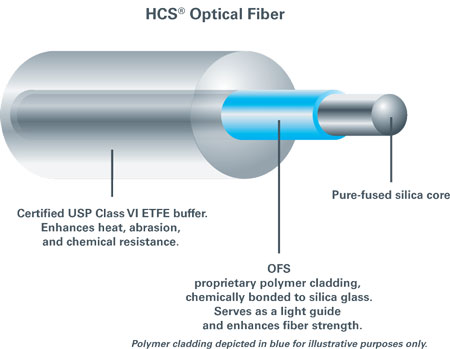
HCS® (Hard-Clad Silica) is a problem-solving, polymer coated optical fiber system invented by us in the early years of the optical fiber industry. A proprietary polymer is applied to the pristine surface of pure, fused silica as we draw the glass down to its final, step-index, multimode optical fiber form. We then add additional buffer layers to improve chemical and abrasion resistance. This final step increases the finished diameter to a dimension that is easier for field-technicians to handle.
The result is a low OH fiber that is optimized for use at the 650 and 850 nm wavelengths which are common in transceivers deployed in many industrial applications. The pure silica core is highly transparent. This makes HCS fiber suitable for use over a very broad range of optical wavelengths and in a variety of applications beyond data communications such as fiber optic sensors, spectroscopy and laser delivery. HCS optical fiber is mechanically strong and is uniquely suited to field connectorization for harsh environmental conditions.
HCS optical fiber has the following important characteristics:
- High mechanical strength
- Bend insensitivity
- Crimp-on connector capability similar to electrical wires
- Resistance to harsh chemicals commonly found in industry
- Wide operating temperature range (-65 to +125˚C; -85 to 257˚F)
- Superior crush, twist and flex performance
- Low OH
- Long term reliability
- Ease of handling
The OFS polymer material can be applied to HCS optical fiber as either a cladding or a coating; it’s that versatile. For instance, when applied as a cladding, a thin layer surrounding the light carrying central core, the OFS polymer helps reflect most of the escaping light back into the core and along the length of the fiber. The result is a very strong optical fiber with low attenuation (light loss) and an extremely high core-to-clad ratio. This high core-to-clad ratio is important for reasons of efficiency and systems expense. By using a very thin cladding layer, light transmitting devices are connected to a large core area that efficiently couples more of the optical energy into and along the fiber. This enables systems designers to take advantage of lower cost transceivers and simplified connectors to minimize overall systems expense.
Where is HCS-300 optical fiber used? HCS fibers have an extensive record of success in challenging environments. These range from arc detection applications in electric power substations, to control systems in steel mills, to safety systems in nuclear power plants to trains, planes and, yes, automobiles.
A distinct advantage of HCS optical fiber is the OFS Crimp & Cleave termination method. Our durable polymer enables field technicians to connectorize fibers and cables by crimping connectors directly onto the fiber’s cladding and then cleaving the glass fiber. Like electrical connections, reliable handheld tools are used; no power, no epoxies, no polishing. Quick, easy, and durable.
At OFS Specialty Photonics we focus on applications rather than standardization. The fibers that we design and produce are Application Specific Optical Fibers (ASOF’s) because they lend themselves to your specific needs.
HCS is a registered trademark of OFS, Fitel LLC.
